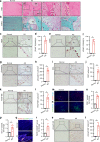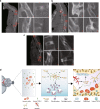Chondrogenesis mediates progression of ankylosing spondylitis through heterotopic ossification
- PMID: 33731675
- PMCID: PMC7969928
- DOI: 10.1038/s41413-021-00140-6
Chondrogenesis mediates progression of ankylosing spondylitis through heterotopic ossification
Abstract
Ankylosing spondylitis (AS) is chronic inflammatory arthritis with a progressive fusion of axial joints. Anti-inflammatory treatments such as anti-TNF-α antibody therapy suppress inflammation but do not effectively halt the progression of spine fusion in AS patients. Here we report that the autoimmune inflammation of AS generates a microenvironment that promotes chondrogenesis in spine ligaments as the process of spine fusion. Chondrocyte differentiation was observed in the ligaments of patients with early-stage AS, and cartilage formation was followed by calcification. Moreover, a large number of giant osteoclasts were found in the inflammatory environment of ligaments and on bony surfaces of calcified cartilage. Resorption activity by these giant osteoclasts generated marrow with high levels of active TGF-β, which induced new bone formation in the ligaments. Notably, no Osterix+ osteoprogenitors were found in osteoclast resorption areas, indicating uncoupled bone resorption and formation. Even at the late and maturation stages, the uncoupled osteoclast resorption in bony interspinous ligament activates TGF-β to induce the progression of ossification in AS patients. Osteoclast resorption of calcified cartilage-initiated ossification in the progression of AS is a similar pathologic process of acquired heterotopic ossification (HO). Our finding of cartilage formation in the ligaments of AS patients revealed that the pathogenesis of spinal fusion is a process of HO and explained why anti-inflammatory treatments do not slow ankylosing once there is new bone formation in spinal soft tissues. Thus, inhibition of HO formation, such as osteoclast activity, cartilage formation, or TGF-β activity could be a potential therapy for AS.
Conflict of interest statement
The authors declare no competing interests.
Figures






Similar articles
-
Periodontal Disease as a Risk Factor for Rheumatoid Arthritis: A Systematic Review.JBI Libr Syst Rev. 2012;10(42 Suppl):1-12. doi: 10.11124/jbisrir-2012-288. JBI Libr Syst Rev. 2012. PMID: 27820156
-
Seropositive Neuromyelitis Optica in a Case of Undiagnosed Ankylosing Spondylitis: A Neuro-Rheumatological Conundrum.Qatar Med J. 2022 Jul 7;2022(3):29. doi: 10.5339/qmj.2022.29. eCollection 2022. Qatar Med J. 2022. PMID: 35864917 Free PMC article.
-
Inhibition of overactive TGF-β attenuates progression of heterotopic ossification in mice.Nat Commun. 2018 Feb 7;9(1):551. doi: 10.1038/s41467-018-02988-5. Nat Commun. 2018. PMID: 29416028 Free PMC article.
-
MicroRNAs in the Pathogenesis of Ankylosing Spondylitis and their Clinical Implication.Curr Mol Med. 2023;23(10):1058-1065. doi: 10.2174/1566524023666221103155119. Curr Mol Med. 2023. PMID: 36330642 Review.
-
[Immunopathology of ankylosing spondylitis and other spondyloarthritides].Z Rheumatol. 2008 Feb;67(1):25-31. doi: 10.1007/s00393-007-0242-9. Z Rheumatol. 2008. PMID: 18214503 Review. German.
Cited by
-
Application of methylation in the diagnosis of ankylosing spondylitis.Clin Rheumatol. 2024 Oct;43(10):3073-3082. doi: 10.1007/s10067-024-07113-0. Epub 2024 Aug 21. Clin Rheumatol. 2024. PMID: 39167325 Review.
-
Rotating Magnetic Field Mitigates Ankylosing Spondylitis Targeting Osteocytes and Chondrocytes via Ameliorating Immune Dysfunctions.Cells. 2023 Mar 23;12(7):972. doi: 10.3390/cells12070972. Cells. 2023. PMID: 37048045 Free PMC article.
-
Investigation of the Shared Biomarkers in Heterotopic Ossification Between Ossification of the Ligamentum Flavum and Ankylosing Spondylitis.Global Spine J. 2025 Jan;15(1):161-174. doi: 10.1177/21925682241255894. Epub 2024 May 17. Global Spine J. 2025. PMID: 38757696 Free PMC article.
-
Analysis of m6A regulators related immune characteristics in ankylosing spondylitis by integrated bioinformatics and computational strategies.Sci Rep. 2024 Feb 1;14(1):2724. doi: 10.1038/s41598-024-53184-z. Sci Rep. 2024. PMID: 38302672 Free PMC article.
-
Targeting chondrocytes for arresting bony fusion in ankylosing spondylitis.Nat Commun. 2021 Nov 11;12(1):6540. doi: 10.1038/s41467-021-26750-6. Nat Commun. 2021. PMID: 34764263 Free PMC article.
References
-
- Sieper J, et al. Persistent reduction of spinal inflammation as assessed by magnetic resonance imaging in patients with ankylosing spondylitis after 2 years of treatment with the anti-tumour necrosis factor agent infliximab. Rheumatology (Oxford) 2005;44:1525–1530. doi: 10.1093/rheumatology/kei046. - DOI - PubMed
Grants and funding
LinkOut - more resources
Full Text Sources
Other Literature Sources
Research Materials

